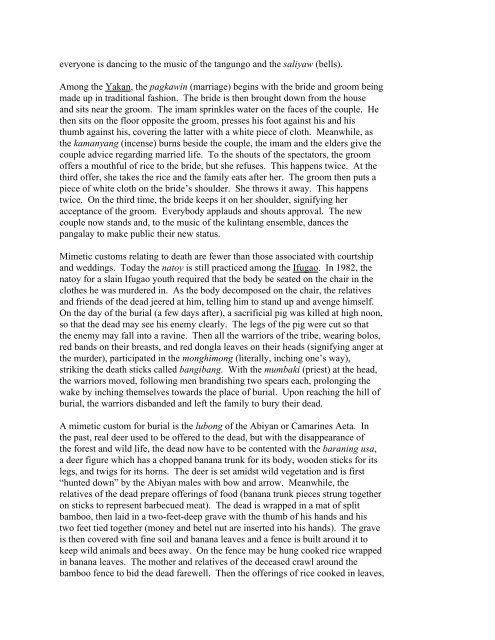THE ETHNIC TRADITION IN PHILIPPINE THEATER In the ...
THE ETHNIC TRADITION IN PHILIPPINE THEATER In the ...
THE ETHNIC TRADITION IN PHILIPPINE THEATER In the ...
You also want an ePaper? Increase the reach of your titles
YUMPU automatically turns print PDFs into web optimized ePapers that Google loves.
everyone is dancing to <strong>the</strong> music of <strong>the</strong> tangungo and <strong>the</strong> saliyaw (bells).<br />
Among <strong>the</strong> Yakan, <strong>the</strong> pagkawin (marriage) begins with <strong>the</strong> bride and groom being<br />
made up in traditional fashion. The bride is <strong>the</strong>n brought down from <strong>the</strong> house<br />
and sits near <strong>the</strong> groom. The imam sprinkles water on <strong>the</strong> faces of <strong>the</strong> couple. He<br />
<strong>the</strong>n sits on <strong>the</strong> floor opposite <strong>the</strong> groom, presses his foot against his and his<br />
thumb against his, covering <strong>the</strong> latter with a white piece of cloth. Meanwhile, as<br />
<strong>the</strong> kamanyang (incense) burns beside <strong>the</strong> couple, <strong>the</strong> imam and <strong>the</strong> elders give <strong>the</strong><br />
couple advice regarding married life. To <strong>the</strong> shouts of <strong>the</strong> spectators, <strong>the</strong> groom<br />
offers a mouthful of rice to <strong>the</strong> bride, but she refuses. This happens twice. At <strong>the</strong><br />
third offer, she takes <strong>the</strong> rice and <strong>the</strong> family eats after her. The groom <strong>the</strong>n puts a<br />
piece of white cloth on <strong>the</strong> bride’s shoulder. She throws it away. This happens<br />
twice. On <strong>the</strong> third time, <strong>the</strong> bride keeps it on her shoulder, signifying her<br />
acceptance of <strong>the</strong> groom. Everybody applauds and shouts approval. The new<br />
couple now stands and, to <strong>the</strong> music of <strong>the</strong> kulintang ensemble, dances <strong>the</strong><br />
pangalay to make public <strong>the</strong>ir new status.<br />
Mimetic customs relating to death are fewer than those associated with courtship<br />
and weddings. Today <strong>the</strong> natoy is still practiced among <strong>the</strong> Ifugao. <strong>In</strong> 1982, <strong>the</strong><br />
natoy for a slain Ifugao youth required that <strong>the</strong> body be seated on <strong>the</strong> chair in <strong>the</strong><br />
clo<strong>the</strong>s he was murdered in. As <strong>the</strong> body decomposed on <strong>the</strong> chair, <strong>the</strong> relatives<br />
and friends of <strong>the</strong> dead jeered at him, telling him to stand up and avenge himself.<br />
On <strong>the</strong> day of <strong>the</strong> burial (a few days after), a sacrificial pig was killed at high noon,<br />
so that <strong>the</strong> dead may see his enemy clearly. The legs of <strong>the</strong> pig were cut so that<br />
<strong>the</strong> enemy may fall into a ravine. Then all <strong>the</strong> warriors of <strong>the</strong> tribe, wearing bolos,<br />
red bands on <strong>the</strong>ir breasts, and red dongla leaves on <strong>the</strong>ir heads (signifying anger at<br />
<strong>the</strong> murder), participated in <strong>the</strong> monghimong (literally, inching one’s way),<br />
striking <strong>the</strong> death sticks called bangibang. With <strong>the</strong> mumbaki (priest) at <strong>the</strong> head,<br />
<strong>the</strong> warriors moved, following men brandishing two spears each, prolonging <strong>the</strong><br />
wake by inching <strong>the</strong>mselves towards <strong>the</strong> place of burial. Upon reaching <strong>the</strong> hill of<br />
burial, <strong>the</strong> warriors disbanded and left <strong>the</strong> family to bury <strong>the</strong>ir dead.<br />
A mimetic custom for burial is <strong>the</strong> lubong of <strong>the</strong> Abiyan or Camarines Aeta. <strong>In</strong><br />
<strong>the</strong> past, real deer used to be offered to <strong>the</strong> dead, but with <strong>the</strong> disappearance of<br />
<strong>the</strong> forest and wild life, <strong>the</strong> dead now have to be contented with <strong>the</strong> baraning usa,<br />
a deer figure which has a chopped banana trunk for its body, wooden sticks for its<br />
legs, and twigs for its horns. The deer is set amidst wild vegetation and is first<br />
“hunted down” by <strong>the</strong> Abiyan males with bow and arrow. Meanwhile, <strong>the</strong><br />
relatives of <strong>the</strong> dead prepare offerings of food (banana trunk pieces strung toge<strong>the</strong>r<br />
on sticks to represent barbecued meat). The dead is wrapped in a mat of split<br />
bamboo, <strong>the</strong>n laid in a two-feet-deep grave with <strong>the</strong> thumb of his hands and his<br />
two feet tied toge<strong>the</strong>r (money and betel nut are inserted into his hands). The grave<br />
is <strong>the</strong>n covered with fine soil and banana leaves and a fence is built around it to<br />
keep wild animals and bees away. On <strong>the</strong> fence may be hung cooked rice wrapped<br />
in banana leaves. The mo<strong>the</strong>r and relatives of <strong>the</strong> deceased crawl around <strong>the</strong><br />
bamboo fence to bid <strong>the</strong> dead farewell. Then <strong>the</strong> offerings of rice cooked in leaves,
















